Which Of The Following Integrals Are Improper? (Select All That Apply.)
Techniques of Integration
27 Improper Integrals
Learning Objectives
- Evaluate an integral over an infinite interval.
- Evaluate an integral over a closed interval with an infinite discontinuity within the interval.
- Use the comparison theorem to determine whether a definite integral is convergent.
Is the area between the graph of ![]() and the x-axis over the interval
and the x-axis over the interval ![]() finite or infinite? If this same region is revolved about the x-axis, is the volume finite or infinite? Surprisingly, the area of the region described is infinite, but the volume of the solid obtained by revolving this region about the x-axis is finite.
finite or infinite? If this same region is revolved about the x-axis, is the volume finite or infinite? Surprisingly, the area of the region described is infinite, but the volume of the solid obtained by revolving this region about the x-axis is finite.
In this section, we define integrals over an infinite interval as well as integrals of functions containing a discontinuity on the interval. Integrals of these types are called improper integrals. We examine several techniques for evaluating improper integrals, all of which involve taking limits.
Integrating over an Infinite Interval
How should we go about defining an integral of the type ![]() We can integrate
We can integrate ![]() for any value of
for any value of ![]() so it is reasonable to look at the behavior of this integral as we substitute larger values of
so it is reasonable to look at the behavior of this integral as we substitute larger values of ![]() (Figure) shows that
(Figure) shows that ![]() may be interpreted as area for various values of
may be interpreted as area for various values of ![]() In other words, we may define an improper integral as a limit, taken as one of the limits of integration increases or decreases without bound.
In other words, we may define an improper integral as a limit, taken as one of the limits of integration increases or decreases without bound.
To integrate a function over an infinite interval, we consider the limit of the integral as the upper limit increases without bound.

Definition
- Let
 be continuous over an interval of the form
be continuous over an interval of the form  Then
Then

provided this limit exists. - Let
 be continuous over an interval of the form
be continuous over an interval of the form ![Rendered by QuickLaTeX.com \left(\text{−}\infty ,b\right].](https://opentextbc.ca/calculusv2openstax/wp-content/ql-cache/quicklatex.com-c0af9c101fa55272b5d11e5a5a9e78ff_l3.png) Then
Then

provided this limit exists.
In each case, if the limit exists, then the improper integral is said to converge. If the limit does not exist, then the improper integral is said to diverge. - Let
 be continuous over
be continuous over  Then
Then

provided that and
and  both converge. If either of these two integrals diverge, then
both converge. If either of these two integrals diverge, then  diverges. (It can be shown that, in fact,
diverges. (It can be shown that, in fact,  for any value of
for any value of 
In our first example, we return to the question we posed at the start of this section: Is the area between the graph of ![]() and the
and the ![]() -axis over the interval
-axis over the interval ![]() finite or infinite?
finite or infinite?
Finding an Area
Determine whether the area between the graph of ![]() and the x-axis over the interval
and the x-axis over the interval ![]() is finite or infinite.
is finite or infinite.
We first do a quick sketch of the region in question, as shown in the following graph.
We can find the area between the curve ![]() and the x-axis on an infinite interval.
and the x-axis on an infinite interval.
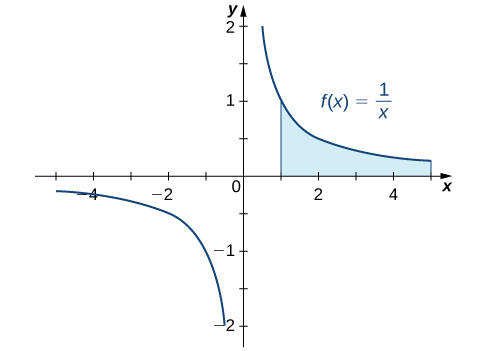
We can see that the area of this region is given by ![]() Then we have
Then we have

Since the improper integral diverges to ![]() the area of the region is infinite.
the area of the region is infinite.
Finding a Volume
Find the volume of the solid obtained by revolving the region bounded by the graph of ![]() and the x-axis over the interval
and the x-axis over the interval ![]() about the
about the ![]() -axis.
-axis.
The solid is shown in (Figure). Using the disk method, we see that the volume V is
![]()
The solid of revolution can be generated by rotating an infinite area about the x-axis.

Then we have
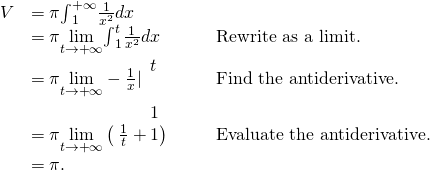
The improper integral converges to ![]() Therefore, the volume of the solid of revolution is
Therefore, the volume of the solid of revolution is ![]()
In conclusion, although the area of the region between the x-axis and the graph of ![]() over the interval
over the interval ![]() is infinite, the volume of the solid generated by revolving this region about the x-axis is finite. The solid generated is known as Gabriel's Horn .
is infinite, the volume of the solid generated by revolving this region about the x-axis is finite. The solid generated is known as Gabriel's Horn .
Visit this website to read more about Gabriel's Horn.
Chapter Opener: Traffic Accidents in a City
(credit: modification of work by David McKelvey, Flickr)

In the chapter opener, we stated the following problem: Suppose that at a busy intersection, traffic accidents occur at an average rate of one every three months. After residents complained, changes were made to the traffic lights at the intersection. It has now been eight months since the changes were made and there have been no accidents. Were the changes effective or is the 8-month interval without an accident a result of chance?
Probability theory tells us that if the average time between events is ![]() the probability that
the probability that ![]() the time between events, is between
the time between events, is between ![]() and
and ![]() is given by
is given by
![]()
Thus, if accidents are occurring at a rate of one every 3 months, then the probability that ![]() the time between accidents, is between
the time between accidents, is between ![]() and
and ![]() is given by
is given by
![]()
To answer the question, we must compute ![]() and decide whether it is likely that 8 months could have passed without an accident if there had been no improvement in the traffic situation.
and decide whether it is likely that 8 months could have passed without an accident if there had been no improvement in the traffic situation.
We need to calculate the probability as an improper integral:
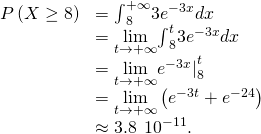
The value ![]() represents the probability of no accidents in 8 months under the initial conditions. Since this value is very, very small, it is reasonable to conclude the changes were effective.
represents the probability of no accidents in 8 months under the initial conditions. Since this value is very, very small, it is reasonable to conclude the changes were effective.
Evaluating an Improper Integral over an Infinite Interval
Evaluate ![]() State whether the improper integral converges or diverges.
State whether the improper integral converges or diverges.
Begin by rewriting ![]() as a limit using (Figure) from the definition. Thus,
as a limit using (Figure) from the definition. Thus,

The improper integral converges to ![]()
Evaluating an Improper Integral on ![]()
Evaluate ![]() State whether the improper integral converges or diverges.
State whether the improper integral converges or diverges.
Start by splitting up the integral:
![]()
If either ![]() or
or ![]() diverges, then
diverges, then ![]() diverges. Compute each integral separately. For the first integral,
diverges. Compute each integral separately. For the first integral,
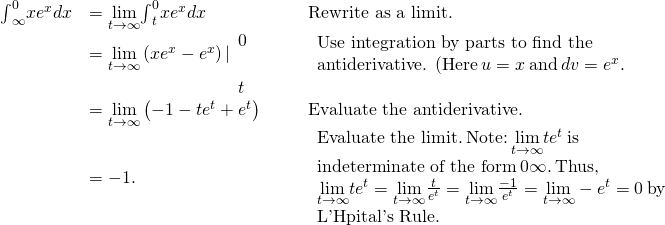
The first improper integral converges. For the second integral,

Thus, ![]() diverges. Since this integral diverges,
diverges. Since this integral diverges, ![]() diverges as well.
diverges as well.
Evaluate ![]() State whether the improper integral converges or diverges.
State whether the improper integral converges or diverges.
![]() converges
converges
Hint
![]()
Integrating a Discontinuous Integrand
Now let's examine integrals of functions containing an infinite discontinuity in the interval over which the integration occurs. Consider an integral of the form ![]() where
where ![]() is continuous over
is continuous over ![]() and discontinuous at
and discontinuous at ![]() Since the function
Since the function ![]() is continuous over
is continuous over ![]() for all values of
for all values of ![]() satisfying
satisfying ![]() the integral
the integral ![]() is defined for all such values of
is defined for all such values of ![]() Thus, it makes sense to consider the values of
Thus, it makes sense to consider the values of ![]() as
as ![]() approaches
approaches ![]() for
for ![]() That is, we define
That is, we define ![]() provided this limit exists. (Figure) illustrates
provided this limit exists. (Figure) illustrates ![]() as areas of regions for values of
as areas of regions for values of ![]() approaching
approaching ![]()
As t approaches b from the left, the value of the area from a to t approaches the area from a to b.

We use a similar approach to define ![]() where
where ![]() is continuous over
is continuous over ![]() and discontinuous at
and discontinuous at ![]() We now proceed with a formal definition.
We now proceed with a formal definition.
The following examples demonstrate the application of this definition.
Integrating a Discontinuous Integrand
Evaluate ![]() if possible. State whether the integral converges or diverges.
if possible. State whether the integral converges or diverges.
The function ![]() is continuous over
is continuous over ![]() and discontinuous at 4. Using (Figure) from the definition, rewrite
and discontinuous at 4. Using (Figure) from the definition, rewrite ![]() as a limit:
as a limit:

The improper integral converges.
Integrating a Discontinuous Integrand
Evaluate ![]() State whether the integral converges or diverges.
State whether the integral converges or diverges.
Since ![]() is continuous over
is continuous over ![]() and is discontinuous at zero, we can rewrite the integral in limit form using (Figure):
and is discontinuous at zero, we can rewrite the integral in limit form using (Figure):

The improper integral converges.
Integrating a Discontinuous Integrand
Evaluate ![]() State whether the improper integral converges or diverges.
State whether the improper integral converges or diverges.
Since ![]() is discontinuous at zero, using (Figure), we can write
is discontinuous at zero, using (Figure), we can write
![]()
If either of the two integrals diverges, then the original integral diverges. Begin with ![]()

Therefore, ![]() diverges. Since
diverges. Since ![]() diverges,
diverges, ![]() diverges.
diverges.
Evaluate ![]() State whether the integral converges or diverges.
State whether the integral converges or diverges.
![]() diverges
diverges
Hint
Write ![]() in limit form using (Figure).
in limit form using (Figure).
A Comparison Theorem
It is not always easy or even possible to evaluate an improper integral directly; however, by comparing it with another carefully chosen integral, it may be possible to determine its convergence or divergence. To see this, consider two continuous functions ![]() and
and ![]() satisfying
satisfying ![]() for
for ![]() ((Figure)). In this case, we may view integrals of these functions over intervals of the form
((Figure)). In this case, we may view integrals of these functions over intervals of the form ![]() as areas, so we have the relationship
as areas, so we have the relationship
![]()
Thus, if
![]()
then
![]() as well. That is, if the area of the region between the graph of
as well. That is, if the area of the region between the graph of ![]() and the x-axis over
and the x-axis over ![]() is infinite, then the area of the region between the graph of
is infinite, then the area of the region between the graph of ![]() and the x-axis over
and the x-axis over ![]() is infinite too.
is infinite too.
On the other hand, if
![]() for some real number
for some real number ![]() then
then
![]() must converge to some value less than or equal to
must converge to some value less than or equal to ![]() since
since ![]() increases as
increases as ![]() increases and
increases and ![]() for all
for all ![]()
If the area of the region between the graph of ![]() and the x-axis over
and the x-axis over ![]() is finite, then the area of the region between the graph of
is finite, then the area of the region between the graph of ![]() and the x-axis over
and the x-axis over ![]() is also finite.
is also finite.
These conclusions are summarized in the following theorem.
Applying the Comparison Theorem
Use a comparison to show that ![]() converges.
converges.
We can see that
![]()
so if ![]() converges, then so does
converges, then so does ![]() To evaluate
To evaluate ![]() first rewrite it as a limit:
first rewrite it as a limit:
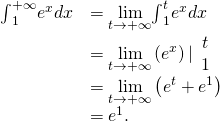
Since ![]() converges, so does
converges, so does ![]()
Use a comparison to show that ![]() diverges.
diverges.
Since ![]()
![]() diverges.
diverges.
Hint
![]() on
on ![]()
Laplace Transforms
In the last few chapters, we have looked at several ways to use integration for solving real-world problems. For this next project, we are going to explore a more advanced application of integration: integral transforms. Specifically, we describe the Laplace transform and some of its properties. The Laplace transform is used in engineering and physics to simplify the computations needed to solve some problems. It takes functions expressed in terms of time and transforms them to functions expressed in terms of frequency. It turns out that, in many cases, the computations needed to solve problems in the frequency domain are much simpler than those required in the time domain.
The Laplace transform is defined in terms of an integral as
![]()
Note that the input to a Laplace transform is a function of time, ![]() and the output is a function of frequency,
and the output is a function of frequency, ![]() Although many real-world examples require the use of complex numbers (involving the imaginary number
Although many real-world examples require the use of complex numbers (involving the imaginary number ![]() in this project we limit ourselves to functions of real numbers.
in this project we limit ourselves to functions of real numbers.
Let's start with a simple example. Here we calculate the Laplace transform of ![]() . We have
. We have
![]()
This is an improper integral, so we express it in terms of a limit, which gives
![]()
Now we use integration by parts to evaluate the integral. Note that we are integrating with respect to t, so we treat the variable s as a constant. We have
![]()
Then we obtain
![Rendered by QuickLaTeX.com \begin{array}{cc}\hfill \underset{z\to \infty }{\text{lim}}{\int }_{0}^{z}t{e}^{\text{−}st}dt& =\underset{z\to \infty }{\text{lim}}\left[{\left[-\frac{t}{s}{e}^{\text{−}st}\right]|}_{0}^{z}+\frac{1}{s}{\int }_{0}^{z}{e}^{\text{−}st}dt\right]\hfill \\ & =\underset{z\to \infty }{\text{lim}}\left[\left[-\frac{z}{s}{e}^{\text{−}sz}+\frac{0}{s}{e}^{-0s}\right]+\frac{1}{s}{\int }_{0}^{z}{e}^{\text{−}st}dt\right]\hfill \\ & =\underset{z\to \infty }{\text{lim}}\left[\left[-\frac{z}{s}{e}^{\text{−}sz}+0\right]-\frac{1}{s}{\left[\frac{{e}^{\text{−}st}}{s}\right]|}_{0}^{z}\right]\hfill \\ & =\underset{z\to \infty }{\text{lim}}\left[\left[-\frac{z}{s}{e}^{\text{−}sz}\right]-\frac{1}{{s}^{2}}\left[{e}^{\text{−}sz}-1\right]\right]\hfill \\ & =\underset{z\to \infty }{\text{lim}}\left[-\frac{z}{s{e}^{sz}}\right]-\underset{z\to \infty }{\text{lim}}\left[\frac{1}{{s}^{2}{e}^{sz}}\right]+\underset{z\to \infty }{\text{lim}}\frac{1}{{s}^{2}}\hfill \\ & =0-0+\frac{1}{{s}^{2}}\hfill \\ & =\frac{1}{{s}^{2}}.\hfill \end{array}](https://opentextbc.ca/calculusv2openstax/wp-content/ql-cache/quicklatex.com-7f0d63a107c55962e5fb2976cd20b78b_l3.png)
- Calculate the Laplace transform of

- Calculate the Laplace transform of

- Calculate the Laplace transform of
 (Note, you will have to integrate by parts twice.)
(Note, you will have to integrate by parts twice.)
Laplace transforms are often used to solve differential equations. Differential equations are not covered in detail until later in this book; but, for now, let's look at the relationship between the Laplace transform of a function and the Laplace transform of its derivative.
Let's start with the definition of the Laplace transform. We have

- Use integration by parts to evaluate
 (Let
(Let  and
and 
After integrating by parts and evaluating the limit, you should see that
![Rendered by QuickLaTeX.com L\left\{f\left(t\right)\right\}=\frac{f\left(0\right)}{s}+\frac{1}{s}\left[L\left\{{f}^{\prime }\left(t\right)\right\}\right].](https://opentextbc.ca/calculusv2openstax/wp-content/ql-cache/quicklatex.com-3b5b09654fbdbfa14592e5023de6a893_l3.png)
Then,

Thus, differentiation in the time domain simplifies to multiplication by s in the frequency domain.
The final thing we look at in this project is how the Laplace transforms of and its antiderivative are related. Let
and its antiderivative are related. Let  Then,
Then,

- Use integration by parts to evaluate
 (Let
(Let  and
and  Note, by the way, that we have defined
Note, by the way, that we have defined 

As you might expect, you should see that

Integration in the time domain simplifies to division by s in the frequency domain.
Key Concepts
- Integrals of functions over infinite intervals are defined in terms of limits.
- Integrals of functions over an interval for which the function has a discontinuity at an endpoint may be defined in terms of limits.
- The convergence or divergence of an improper integral may be determined by comparing it with the value of an improper integral for which the convergence or divergence is known.
Key Equations
- Improper integrals

Evaluate the following integrals. If the integral is not convergent, answer "divergent."
![]()
divergent
![]()
![]()
![]()
![]()
![]()
![]()
![]()
Without integrating, determine whether the integral ![]() converges or diverges by comparing the function
converges or diverges by comparing the function ![]() with
with ![]()
Converges
Without integrating, determine whether the integral ![]() converges or diverges.
converges or diverges.
Determine whether the improper integrals converge or diverge. If possible, determine the value of the integrals that converge.
![]()
Converges to 1/2.
![]()
![]()
−4
![]()
![]()
![]()
![]()
![]()
diverges
![]()
![]()
diverges
![]()
![]()
1.5
![]()
![]()
diverges
![]()
![]()
diverges
![]()
![]()
diverges
Determine the convergence of each of the following integrals by comparison with the given integral. If the integral converges, find the number to which it converges.
![]() compare with
compare with ![]()
![]() compare with
compare with ![]()
Both integrals diverge.
Evaluate the integrals. If the integral diverges, answer "diverges."
![]()
![]()
diverges
![]()
![]()
diverges
![]()
![]()
![]()
![]()
![]()
0.0
![]()
![]()
0.0
![]()
Evaluate the improper integrals. Each of these integrals has an infinite discontinuity either at an endpoint or at an interior point of the interval.
![]()
6.0
![]()
![]()
![]()
![]()
![]()
![]()
![]()
Evaluate ![]() (Be careful!) (Express your answer using three decimal places.)
(Be careful!) (Express your answer using three decimal places.)
![]()
Evaluate ![]() (Express the answer in exact form.)
(Express the answer in exact form.)
Evaluate ![]()
![]()
Find the area of the region in the first quadrant between the curve ![]() and the x-axis.
and the x-axis.
Find the area of the region bounded by the curve ![]() the x-axis, and on the left by
the x-axis, and on the left by ![]()
7.0
Find the area under the curve ![]() bounded on the left by
bounded on the left by ![]()
Find the area under ![]() in the first quadrant.
in the first quadrant.
![]()
Find the volume of the solid generated by revolving about the y-axis the region under the curve ![]() in the first quadrant.
in the first quadrant.
![]()
Find the volume of the solid generated by revolving about the x-axis the area under the curve ![]() in the first quadrant.
in the first quadrant.
The Laplace transform of a continuous function over the interval ![]() is defined by
is defined by ![]() (see the Student Project). This definition is used to solve some important initial-value problems in differential equations, as discussed later. The domain of F is the set of all real numbers s such that the improper integral converges. Find the Laplace transform F of each of the following functions and give the domain of F.
(see the Student Project). This definition is used to solve some important initial-value problems in differential equations, as discussed later. The domain of F is the set of all real numbers s such that the improper integral converges. Find the Laplace transform F of each of the following functions and give the domain of F.
![]()
![]()
![]()
![]()
![]()
![]()
Use the formula for arc length to show that the circumference of the circle ![]() is
is ![]()
Answers will vary.
A function is a probability density function if it satisfies the following definition: ![]() The probability that a random variable x lies between a and b is given by
The probability that a random variable x lies between a and b is given by ![]()
Show that ![]() is a probability density function.
is a probability density function.
Find the probability that x is between 0 and 0.3. (Use the function defined in the preceding problem.) Use four-place decimal accuracy.
0.8775
Chapter Review Exercises
For the following exercises, determine whether the statement is true or false. Justify your answer with a proof or a counterexample.
![]() cannot be integrated by parts.
cannot be integrated by parts.
![]() cannot be integrated using partial fractions.
cannot be integrated using partial fractions.
False
In numerical integration, increasing the number of points decreases the error.
Integration by parts can always yield the integral.
False
For the following exercises, evaluate the integral using the specified method.
![]() using integration by parts
using integration by parts
![]() using trigonometric substitution
using trigonometric substitution
![]()
![]() using integration by parts
using integration by parts
![]() using partial fractions
using partial fractions
![]()
![]() using trigonometric substitution
using trigonometric substitution
![]() using a table of integrals or a CAS
using a table of integrals or a CAS
![]()
For the following exercises, integrate using whatever method you choose.
![]()
![]()
![]()
![]()
![]()
![]()
![]()
For the following exercises, approximate the integrals using the midpoint rule, trapezoidal rule, and Simpson's rule using four subintervals, rounding to three decimals.
[T] ![]()
![]()
[T] ![]()
[T] ![]()
![]()
For the following exercises, evaluate the integrals, if possible.
![]() for what values of
for what values of ![]() does this integral converge or diverge?
does this integral converge or diverge?
![]()
approximately 0.2194
For the following exercises, consider the gamma function given by ![]()
Show that ![]()
Extend to show that ![]() assuming
assuming ![]() is a positive integer.
is a positive integer.
The fastest car in the world, the Bugati Veyron, can reach a top speed of 408 km/h. The graph represents its velocity.
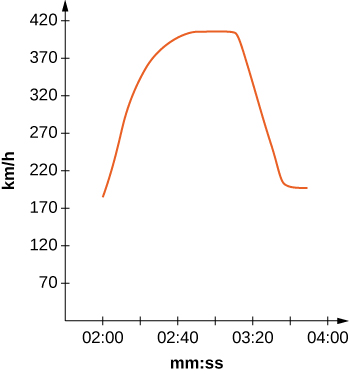
[T] Use the graph to estimate the velocity every 20 sec and fit to a graph of the form ![]() (Hint: Consider the time units.)
(Hint: Consider the time units.)
[T] Using your function from the previous problem, find exactly how far the Bugati Veyron traveled in the 1 min 40 sec included in the graph.
Answers may vary. Ex: ![]() km
km
Glossary
- improper integral
- an integral over an infinite interval or an integral of a function containing an infinite discontinuity on the interval; an improper integral is defined in terms of a limit. The improper integral converges if this limit is a finite real number; otherwise, the improper integral diverges
Which Of The Following Integrals Are Improper? (Select All That Apply.)
Source: https://opentextbc.ca/calculusv2openstax/chapter/improper-integrals/
Posted by: cruzobarresidde.blogspot.com

0 Response to "Which Of The Following Integrals Are Improper? (Select All That Apply.)"
Post a Comment